6th Street Bridge crew gets the job done with a lot of woman power
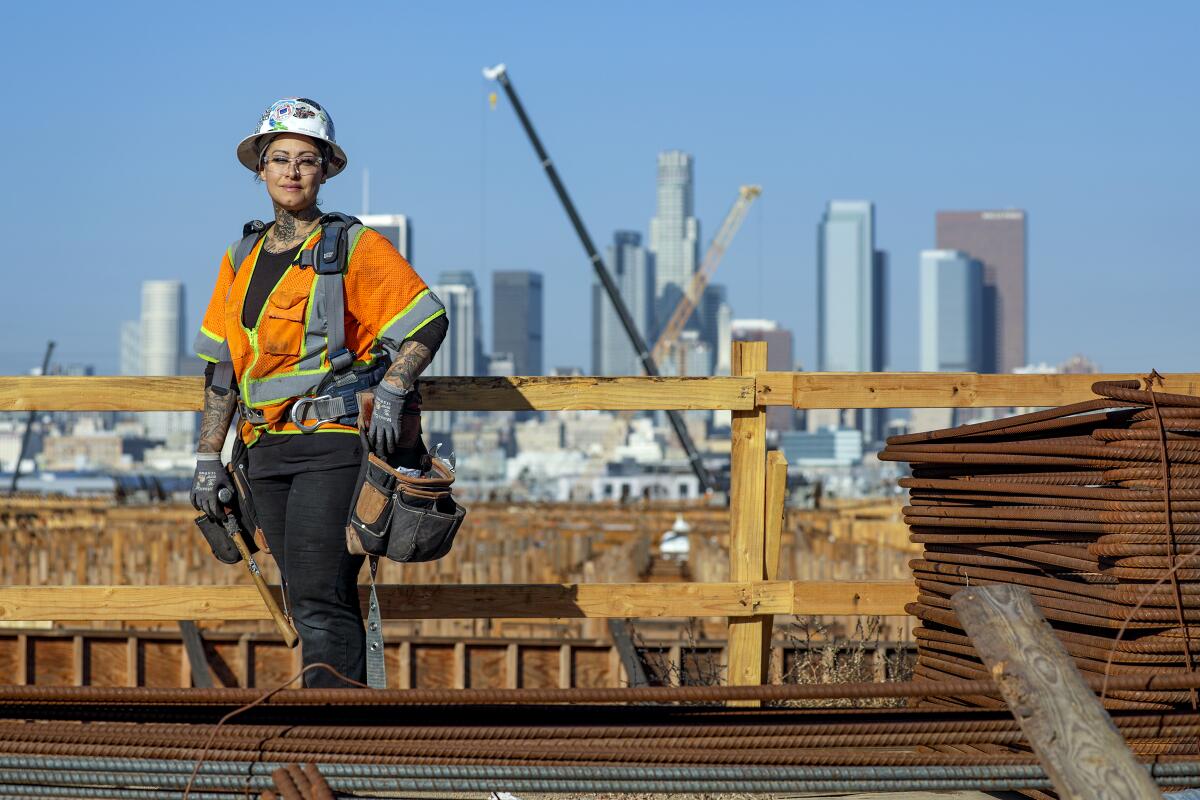
- Share via
Maria Coronado has building in her blood.
Her grandmother was a World War II riveter and her grandfather a lifelong woodworker. Coronado, who grew up learning how to bake bread as skillfully as she knew how to fix a combustion engine, was often the only woman on a site to wield a hammer when she started in construction in 1990.
Nearly 30 years later, she’s a mentor to those who’ve followed in her footsteps, answering late-night calls helping women navigate a male-dominated field. That includes a group of women rebuilding downtown Los Angeles’ 6th Street Bridge — a once iconic landmark stretching across the L.A. River that was torn down in 2016 after it was deemed an earthquake hazard.
“What I’m always telling them is to own your skills,” said Coronado, 52. “Outshine everybody.”
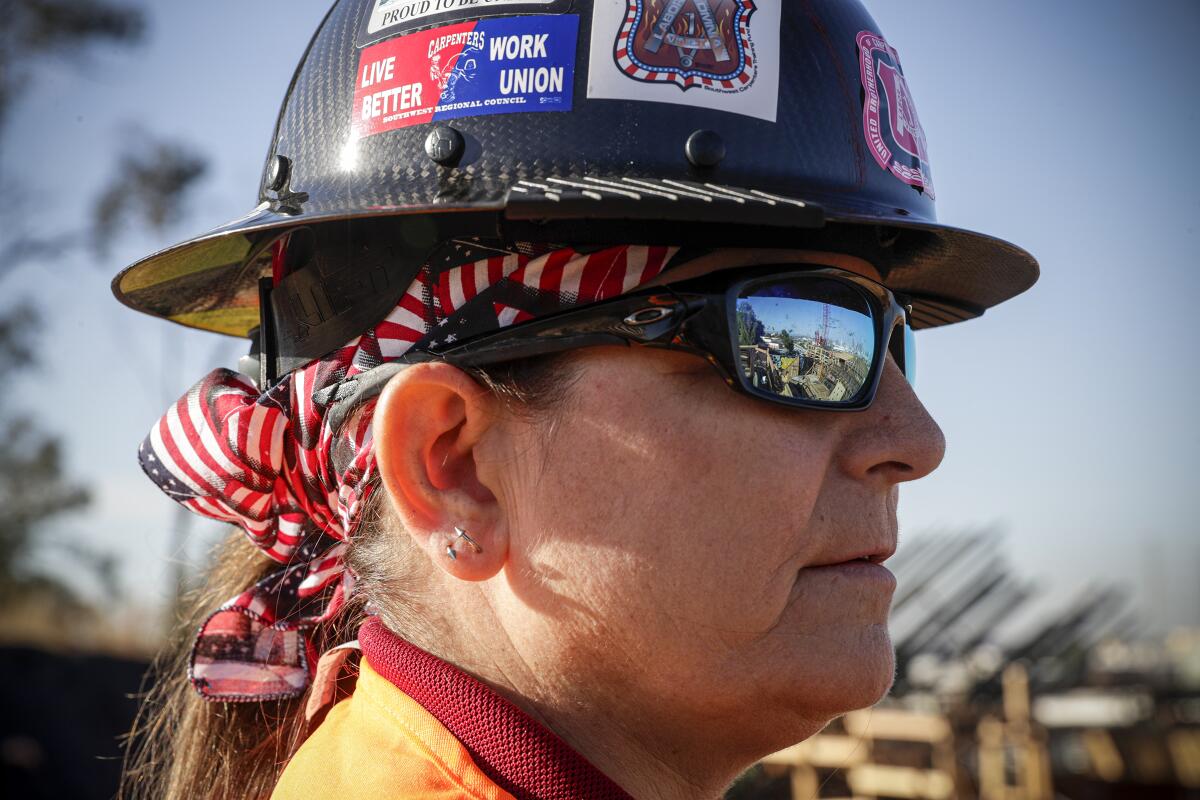
The 6th Street Bridge team of 170 includes 15 women — the most on any commercial project in Los Angeles and nearly double the Department of Labor’s participation goal of 6.9% female crew members. The $428-million project is being constructed by Swedish construction company Skanska, in a joint venture with San Francisco-based Stacy and Witbeck. Skanska includes a senior executive team that is half women.
Rosa Garcia, 37, remembers the first day she stepped onto the downtown Los Angeles site.
“There’s been jobs where there’s been 800 guys and one female — and I’ve been the only female,” the mother of four said. “This is the first project that I walked on to where I couldn’t believe how many women I saw.”
Garcia had spent years working in retail before picking up a hammer four years ago. While going through a divorce, she learned of a pre-apprenticeship recruitment program called Bridging Outstanding Opportunities with Tradeswoman Skills, or BOOTS. The training, in partnership with the Southwest Regional Council of Carpenters union, is designed to prepare women for a career in carpentry.
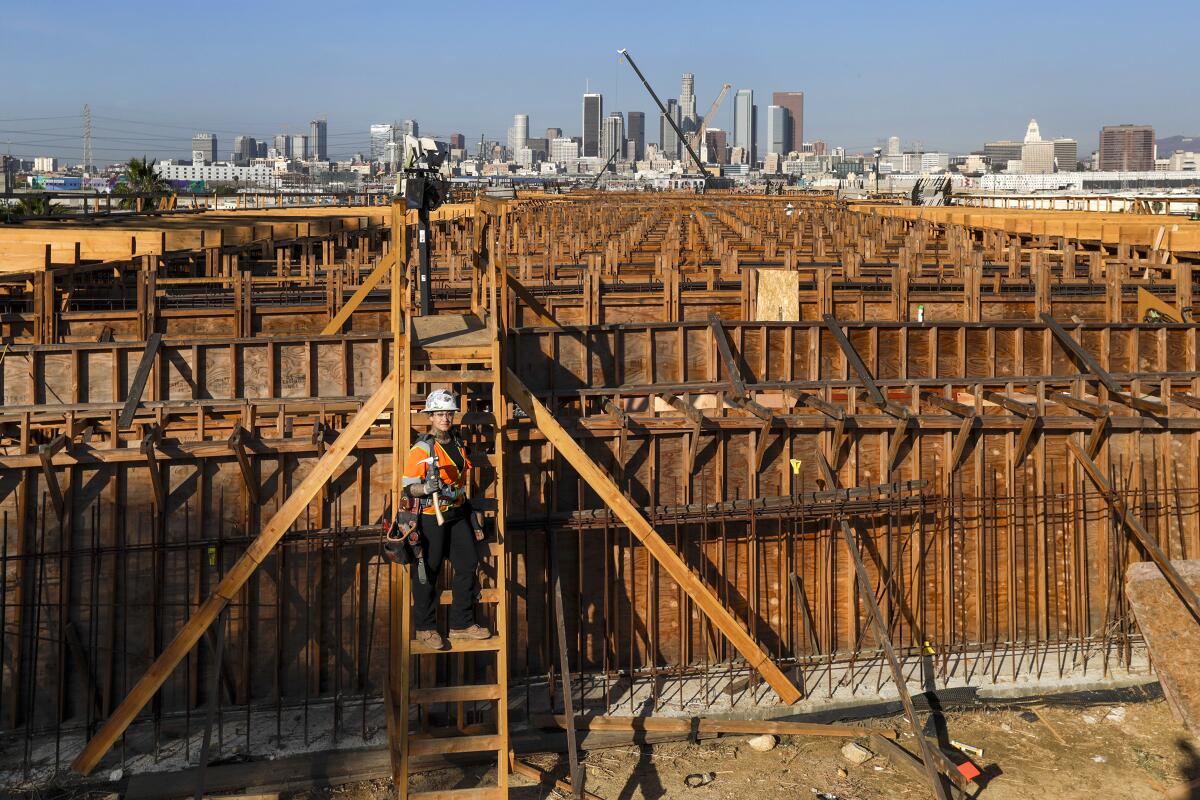
Coronado, a special representative with the carpenters union and the first female lead of a local union in a major metropolitan city, taught Garcia to “check her feelings” before she entered the construction zone, where orders are barked and words are rarely minced.
“You have to have a voice when you’re in construction,” Coronado said. “You have to communicate. It’s a life-or-death situation sometimes. You have to say what needs to be said without fear of consequences.”
According to the Bureau of Labor Statistics, the construction industry is composed of roughly 9% women, including those in clerical and administrative roles not in the field. That statistic is lower for those who actually work on active job sites: about 3.4%.
Coronado says the low number is partly because many women don’t think they can do the physical work. But amid the building boom in L.A., she said the answer to a shortage in “manpower” could be woman power.
“I don’t really understand why women don’t just say, ‘Hey, I can be an ironworker, I can be a carpenter, I can be a window washer, I can do whatever I want,’ ” she said. “I think because I had somebody telling me that, I was daring enough to even give this a shot.
Some of the guys would say, ‘Hey, why aren’t you behind a desk with your nails painted in a cute little dress?’ And I’d say, ‘Why aren’t you in a suit with tie?’ Some of us are builders.”
Chanel Waits, a second-generation carpenter, is among the female builders on the 6th Street Bridge crew. She is doing concrete work on the bridge, which will eventually span 3,500 feet.
The 24-year-old was training to be a paramedic two years ago when her plans shifted. Her father, who has worked as a union carpenter for 43 years and plans to retire in December, suggested she look into construction. A fear of stereotypical cat-calling construction workers made her hesitant to enter a field where she knew she’d be outnumbered. Now, that irony drives her to continue the work.
“I’m not going to tell you it’s been easy, but it hasn’t been impossible,” she said. “If anything, it encourages me to keep going because if I can change the minds of men who don’t think women belong here, then inevitably they’ll work with women again and there will be a door open that wasn’t open before.”
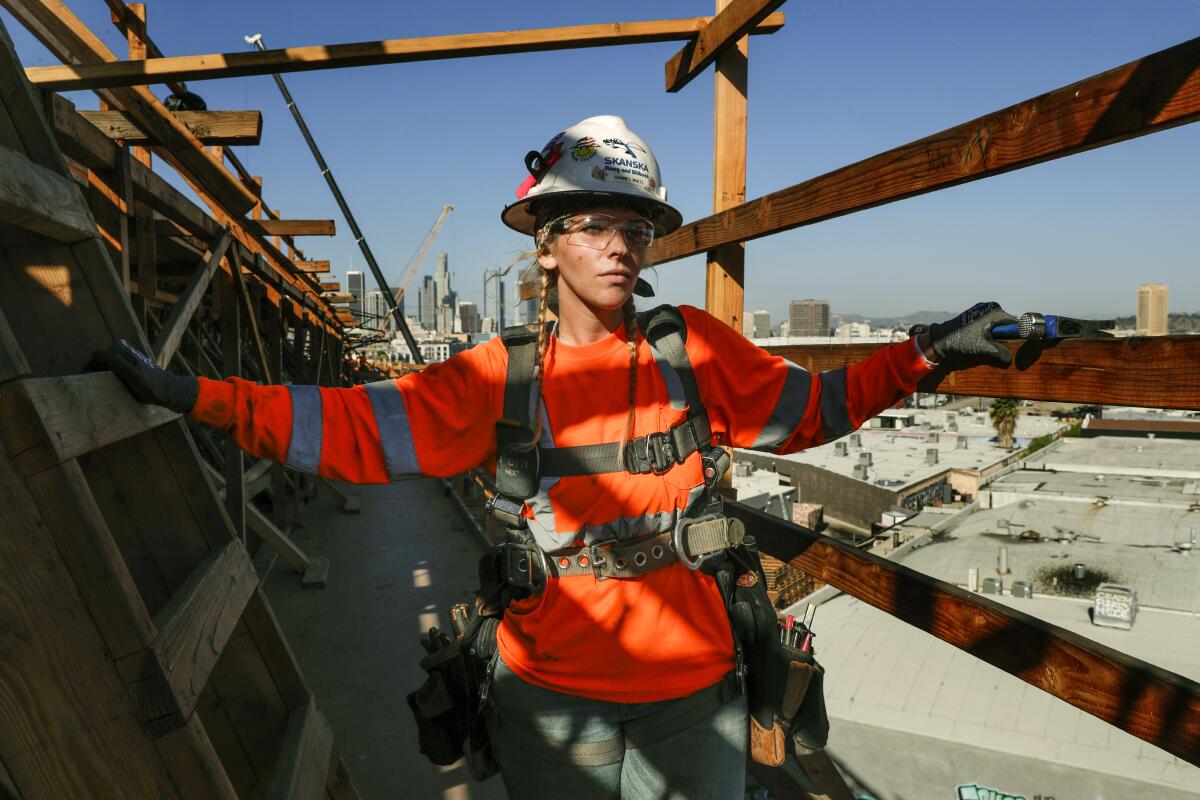
The 6th Street Viaduct, which connects Boyle Heights to downtown Los Angeles, was officially opened in 1933 when a young boy snipped a flower chain extending across the center of the bridge.
The debut of the then-$2.4-million project was six years before the start of World War II, when women headed into the workforce in droves to replace men who had left for war. The women fought to take on physically demanding roles as shipyard workers and aviators, setting a precedent for future generations to embark on what was often identified as men’s work.
By the end of the war, men returned to their positions in the workforce and most women returned to the home, giving rise to the nuclear family structure of the 1950s. But Coronado’s grandmother, a machinist, did not.
After her husband was killed by a train, the single mother of five continued working in order to feed her family. That commitment to providing for family is echoed by women in today’s construction field.
“You’ve got to deal with some negative attitudes, but you push through because you have to support your family — just like men do,” Garcia said.
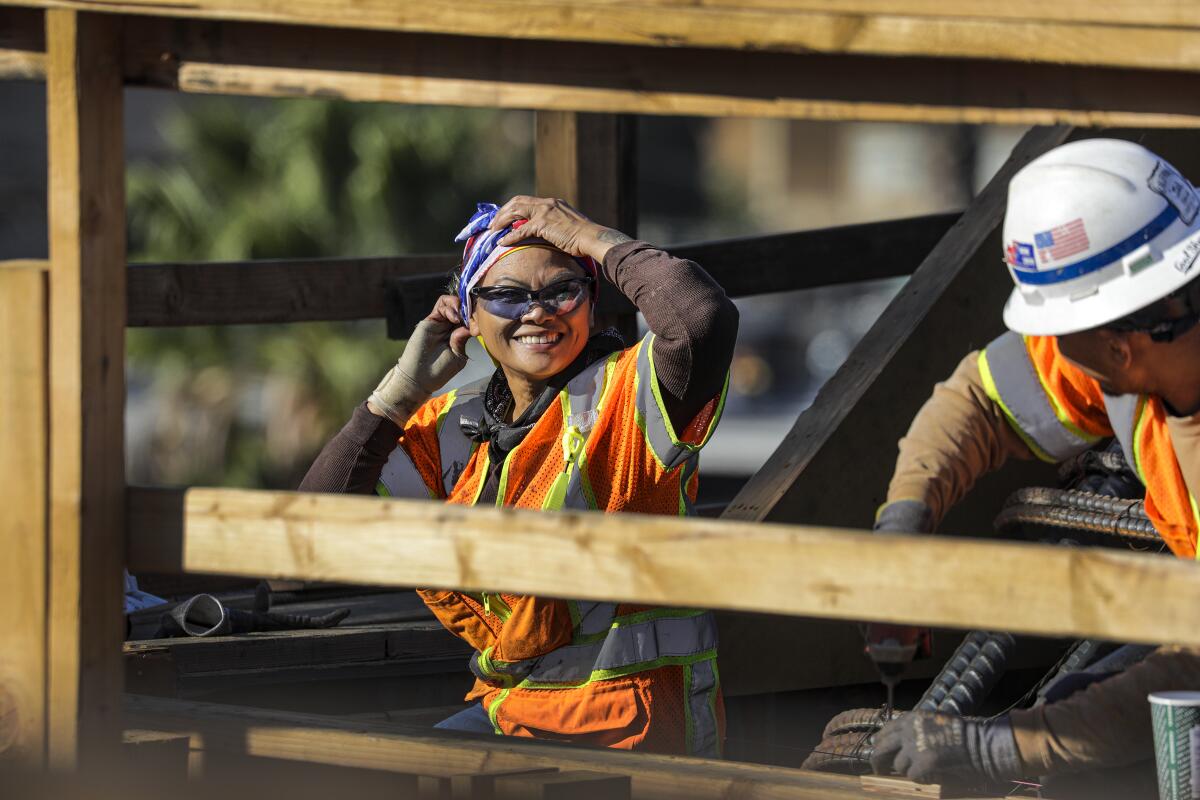
Garcia’s day typically starts at 3 a.m. She hits the road from her home in Riverside and drives to the downtown L.A. site. She’s usually done with her workday by 2:30 p.m., at which time she picks up her 10-year-old twins from daycare and drives them home. She’s typically home by 6 and has only a few hours to feed her kids, get them ready for bed and go to sleep before starting all over again a few hours later.
The grind can be brutal. Bruises come with the territory, Garcia said. She points to the belt she wears throughout the day — it carries 50 pounds of tools. And items worn to balance and safely lock a worker into place weigh another 50 pounds, Waits pointed out.
Dan Langford, executive secretary treasurer for the Southwest Regional Council of Carpenters, said that construction is often a path to the middle class for laborers.
Though the work is physically exhausting and mentally taxing, the pay is lucrative. Although women in the U.S. earn on average 81.8% of what men make, the gender pay gap is reversed in construction, with women earning on average 100.8% of what men make, according to Bureau of Labor statistics cited by the National Assn. of Women in Construction.
“We have to break the perception: Women are physically capable of doing the work,” Langford said.
Eva Johnson, 54, was on probation when she learned about a Los Angeles County program that could train her for a job in construction. She said she’d always been interested in the work but never knew how to get involved.
She’s been in the industry for two years and previously worked on an environmental task force to assist in the aftermath of Malibu’s Woolsey and Hill fires of 2018. In May, she started working on the 6th Street Bridge, a job that challenges her and keep her engaged.
The work has changed her overall lifestyle for the better. And her family supports her too.
“They’re proud of me,” she said.
The overhauled 6th Street Bridge is expected to be completed in 2022 or 2023, giving rise to a new landmark connecting parts of the city. Coronado, who’s worked on projects throughout Los Angeles, from bridges to courthouses, said seeing something built from nothing is a reward in itself.
“When I see a building, I can see all the blood, sweat and tears that went into it, all the people that were on it, all the relationships I built while I was there,” Coronado said. “It’s a serious sense of accomplishment.”
More to Read
Sign up for Essential California
The most important California stories and recommendations in your inbox every morning.
You may occasionally receive promotional content from the Los Angeles Times.











